Audi Q7: Infrared System
Infrared System, Calibrating
Special tools and workshop equipment required
- Vehicle Diagnostic Tester
- Wheel Alignment Computer
- Calibration Tool - Linear Laser -VAS6350/3A- (can be used from the Calibration Tool -VAS6350-)
- Setting Device - Basic Set -VAS6430/1- or Setting Device - Basic Set -VAS6430/1A-
- Night Vision Calibration Tool -VAS6430/6-
 Note
Note
- Check if the Night Vision System Camera -R212- fits correctly in the bracket and the viewing range for the camera is not blocked.
- Make sure the protective window on the Night Vision System Camera -R212- is not chipped. Replace it if necessary. Refer to → Communication; Rep. Gr.91; Infrared System; Night Vision System Camera, Removing and Installing.
- If the vehicle has an adaptive cruise control and night vision system, then the night vision system must be adjusted/calibrated first and after that can the adaptive cruise control be adjusted.
- If the ACC Reflector Mirror - Audi -VAS6430/3- is located on the calibration beam of the Setting Device - Basic Set -VAS6430/1A-, it must be removed.
- Versions with air suspension: drive the vehicle at standard vehicle height
There Are Two Choices for Calibrating:
The "Quick Access"
This procedure should be selected for the following activities if only the calibration/adjustment will be performed.
- "No or incorrect basic setting/adaptation" is stored actively in the DTC memory.
- The camera was removed or replaced,
- The bumper or the radiator grille was removed or replaced,
The "Complete Alignment"
This procedure should be selected for the following activities if a calibration/adjustment and a wheel alignment will be performed.
- Adjustments were made on the rear axle,
- Parts of the suspension were replaced on the vehicle.
 Note
Note
Both procedures are programmed into the axle alignment computer. The respective procedure is performed automatically. It is only necessary to select the appropriate program for the procedure that will be performed.
Preparation Work for Calibrating and Adjusting Driver Assist Systems. Refer to → Chapter "Preparation Work for Calibrating and Adjusting Driver Assist Systems".
Calibrating without a Previous Axle Alignment
- Switch off the ignition when the vehicle has come to a stop. Only this way it can be ensured that the is in the straight-ahead position.
- Mount the quick clamps to the rear wheels.
- Mount the measurement sensor to the rear wheels.
- Select the infrared system calibration procedure in the alignment computer.
Calibrating with a Previous Axle Alignment
- Switch off the ignition when the vehicle has come to a stop. Only this way it can be ensured that the is in the straight-ahead position.
- Connect the battery charger for the battery support mode. Refer to → Electrical Equipment; Rep. Gr.27; Battery; Battery, Charging.
- Position the front wheels so they are straight.
- Connect the Vehicle Diagnostic Tester to the vehicle. (Guide the diagnostic cable through the door window.)
- Turn off all vehicle exterior lamps.
- Close all vehicle door.
Calibrating with or without a Previous Axle Alignment
- Connect the Vehicle Diagnostic Tester to the vehicle. (Guide the diagnostic cable through the door window.)
- Place the Night Vision Calibration Tool -VAS6430/6- centered on the calibration beam from the Setting Device Basic Set -VAS6430/1A-.
- The opening -arrows- must surround the nut and bolt -A- when the Night Vision Calibration Tool -VAS6430/6- is pushed onto the calibration beam.
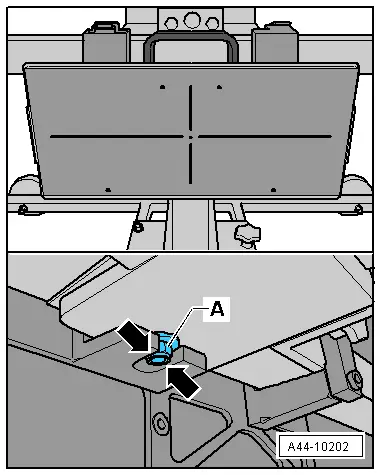
- Fold up the right and left bracket -A-.
- Tighten the right and left clamping screw -1- hand-tight.

- Place the Setting Device Basic Set -VAS6430/1A- with the Night Vision Calibration Tool -VAS6430/6- in front of the vehicle.
- Position the Night Vision Calibration Tool -VAS6430/6- in distance -A- to the night vision camera.
 Note
Note
Distance -A- = 120 cm +- 2.5 cm, measured between the Night Vision Calibration Tool -VAS6430/6- and the lens on the Night Vision System Camera -R212-.
- Attach the measuring sensor for the front wheels to the calibration beam.

- For the following work steps, the hoist must be in the lowest position -A-.
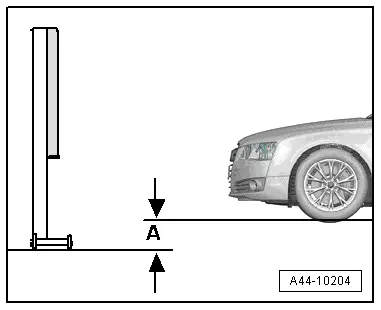
- Place the Calibration Laser -VAS6350/3A--arrow- in the guide of the Night Vision Calibration Tool -VAS6430/6- and tighten.
- Switch on the Calibration Tool - Linear Laser -VAS6350/3-. A laser beam is beamed on the vehicle.
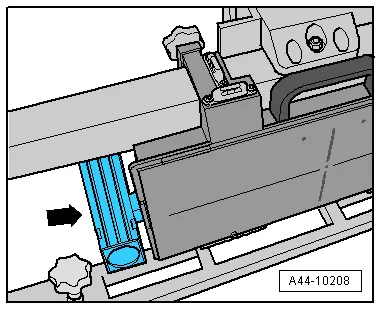
- Turn the lever on the back of the calibration board to align the laser beam so that it is in the center of the camera lens in the horizontal position.
The specified height is now reached and the Linear Laser -VAS6350/3A- can be switched off.
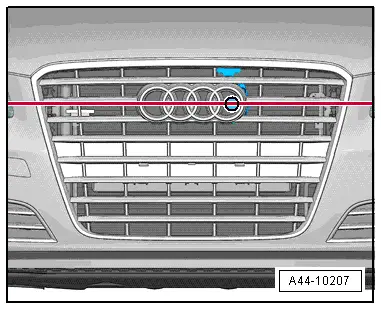
- Level the bubble level -A- using the adjusting screw -1-.
The bubble adjustment -A- serves to compare the ground conditions.
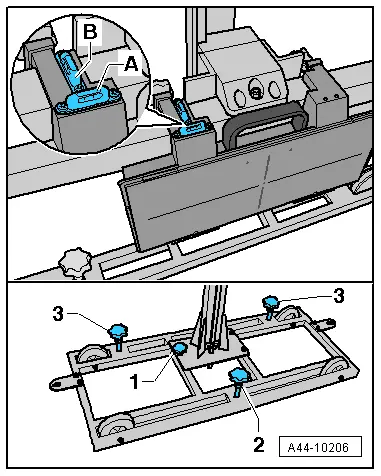
- Move the Setting Device Basic Set -VAS6430/1A- sideways in direction of -arrow B- until the display on the alignment computer is within the tolerance range.
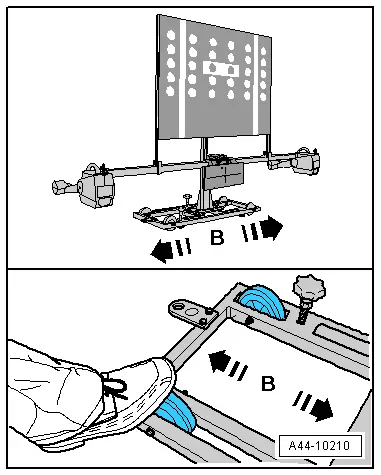
- Secure the Setting Device Basic Set -VAS6430/1- by tightening the bolts -2- and -3- slightly. (This prevents the Setting Device Basic Set -VAS6430- from rolling away).
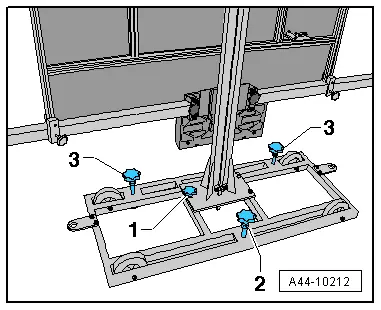
- Turn the precision adjustment screw -1- on the calibration beam until the display on the alignment computer is located within the tolerance range.
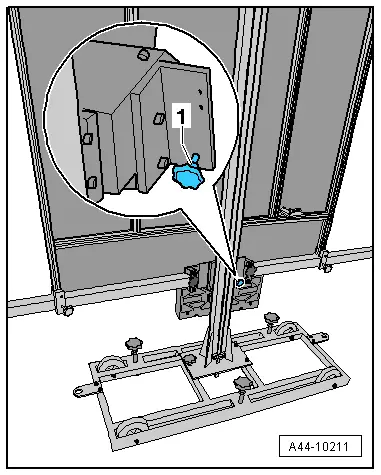
- Level the bubble level -A- using the adjusting screw -1-.
- Level the bubble level -B- using the adjusting screw -2-.

- Turn the Calibration Tool - Linear Laser -VAS6350/3- back on and check the specified height and correct if necessary. A laser beam is beamed on the vehicle.
- Turn the lever on the back of the calibration board to align the laser beam so that it is in the center of the camera lens in the horizontal position.
The specified height is now reached and the Linear Laser -VAS6350/3A- can be switched off.

- Connect the connector -A- for the Night Vision Calibration Tool -VAS6430/6- to the power supply.
- Turn on the switch -B- for the Night Vision Calibration Tool -VAS6430/6-.
 Note
Note
After switching on the Night Vision Calibration Tool -VAS6430/6- an inner initialization takes place. Both LEDs -C- blink at the same time and an acoustic tone will sound if the initialization is successful and was performed without any faults. Then the Night Vision Calibration Tool -VAS6430/6- is in the ready mode. The green LED will blink slowly.
 Note
Note
Check the bubble level and correct the adjustment if necessary.
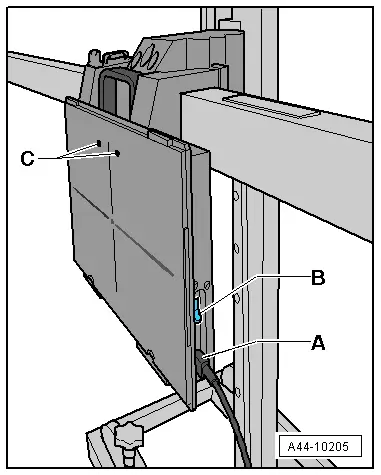
- Push the button -A- to activate the heating function.
An acoustic signal will sound when the heating function is activated. The heat-up phase has begun.
As soon as the specified temperature is reached, the green LED will stay on.
The heating elements switch off automatically after 20 minutes. An acoustic signal will sound approximately 1 minute before the heating elements switch off automatically.
Press the button -A- at any time to reset the timer back to 20 minutes. An short acoustic signal confirms that it has be reset.
Perform Any Subsequent Work Using the Vehicle Diagnostic Tester.
- Connect the Vehicle Diagnostic Tester.
- Switch the ignition on.
- Select and start the Diagnostic operating mode.
- Select the Test plan tab.
- Select the button Individual tests and select the following tree structures one after the other:
- Body
- Electrical system
- 01 - OBD-capable systems
- 84 - Night Vision System Control Module
- 84 - Night Vision System Control Module Functions
- 84 - Control Module, Calibrating
- Start the selected program and follow the instructions in the display of the Vehicle Diagnostic Tester.

Turn the adjusting screw with a Phillips screwdriver to mechanically adjust the Night Vision System Camera -R212- around its roller axle.
- Insert the Phillips screwdriver -arrow- and make the adjustment according to the specification. Refer to Vehicle Diagnostic Tester.
 Note
Note
Make sure there is no one or nothing between the Night Vision System Camera -R212- and the Night Vision Calibration Tool -VAS6430/6- while making the adjustment.
Adjusting the pitch-yaw angle of the Night Vision System Camera -R212- takes place completely electronically via the Vehicle Diagnostic Tester.
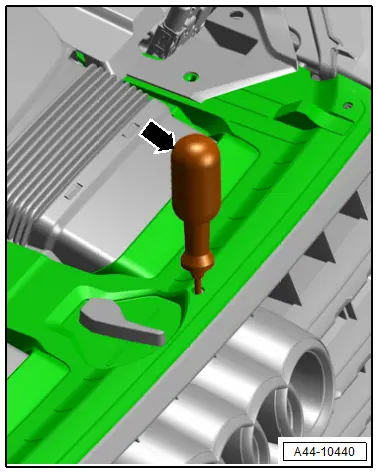
Special Tools
Special tools and workshop equipment required
- Brake Pedal Actuator -VAG1869/2-.
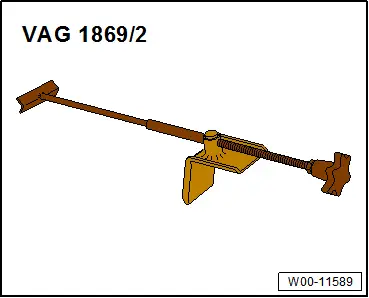
- Calibration Tool - Linear Laser -VAS6350/3A- (can be used from the Calibration Tool -VAS6350-)

- Setting Device - Basic Set -VAS6430/1- or Setting Device - Basic Set -VAS6430/1A-
- Adapter VAS6430/9 -VAS6430/9-, only for surface mounted hoist with a dimension greater than 300 mm.
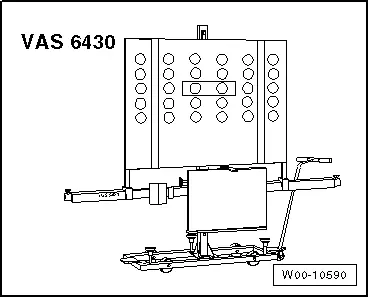
- Steering Wheel Scales -VAS6458-
- Night Vision Calibration Tool -VAS6430/6-
- Vehicle Diagnostic Tester
- Wheel Alignment Computer
- Screwdriver with T-bar VAS272001 -VAS272001-, not shown
- ACC Reflector Mirror - Audi -VAS6430/3-
- Wheel Alignment Computer released by VW/Audi


